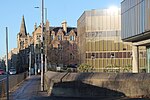Mayfield Salisbury Church
Category B listed buildings in EdinburghChurch of Scotland churches in EdinburghHippolyte Blanc buildingsListed churches in EdinburghUse British English from March 2018

Mayfield Salisbury Church is a member of the Church of Scotland, part of the worldwide family of the Christian Church. It is situated approximately 1.5 miles (2.4 km) south of Edinburgh city centre at the junction of Mayfield Road and West Mayfield. The building was designed by the renowned Scottish architect, Hippolyte Blanc and the main building work took place between 1875 and 1879. It is particularly renowned for the range and quality of its stained glass. An extensive internal renovation of the sanctuary was undertaken in 2009.
Excerpt from the Wikipedia article Mayfield Salisbury Church (License: CC BY-SA 3.0, Authors, Images).Mayfield Salisbury Church
West Mayfield, City of Edinburgh Newington
Geographical coordinates (GPS) Address External links Nearby Places Show on map
Geographical coordinates (GPS)
| Latitude | Longitude |
|---|---|
| N 55.933083333333 ° | E -3.1772027777778 ° |
Address
Mayfield Salisbury Parish Church
West Mayfield
EH9 1TQ City of Edinburgh, Newington
Scotland, United Kingdom
Open on Google Maps








